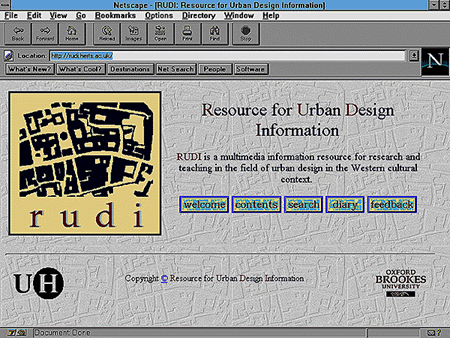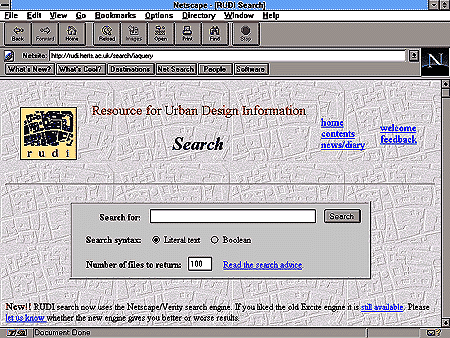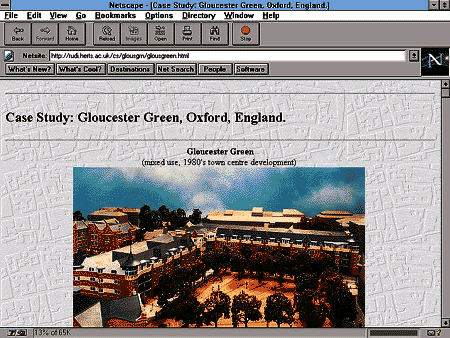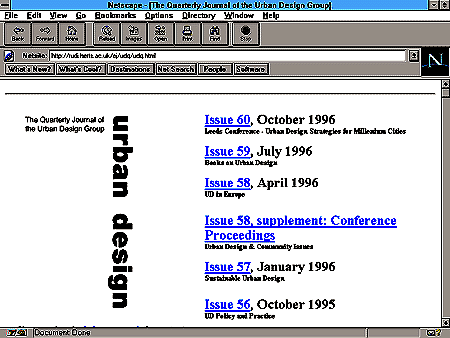|
Articles
Urban Design on the Internet:
RUDI, a case
study in practice
A Paper By
Alan Reeve, Rowena Rouse, Catherine Tranmer,
Bill Worthington.
RUDI is jointly run by the University of Hertfordshire
and Oxford Brookes University
http://rudi.herts.ac.uk/
Introduction
Urban design would seem like an appropriate testing ground for
developing an Internet based resource , constituted as it is quite
naturally of a complex range of materials and media, from theory
to practice, from simple text to 3D representations. This was, indeed,
an initial rationale behind the funding and establishment of RUDI (Resource for Urban Design Information
see Fig. 1). It would answer, that is, to an anticipated demand
for diverse data, information, polemic and instances of good practice,
and be an experimental site providing sufficient (hyper)textual
depth to challenge the most innovative theoretical and technical
structures. After all, architects in education and practice have
for some time been exploring the new medium and its glossy possibilities.
But the RUDI team wanted to provide something with more coherence,
depth and, untrendy as it might seem, seriousness than most sites
appeared to be offering at the inception of the project a year ago.
This was the big issue whose scale has become apparent only slowly
as the project has developed. It was not just a matter of defining
a hitherto healthily unbounded subject, or of constructing a sufficiently
comprehensive, iterational and intelligent knowledge structure -
even if the available search engines had been able to cope with
all of this, which they were not. It was also a matter of the relative
unfamiliarity of urban designers with the new information technology
of the web, and the apparently baroque difficulties of acquiring,
assembling, reinterpreting and publishing material of any worthwhile
content in this brave new medium. The Web has been fantastically
over hyped in the last few short years. The reality is that using
it to deliver services of any quality comparable with those readily
available through the older and seemingly archaic and dry delivery
systems - like books and journals, housed in libraries with relatively
easy to follow cataloguing systems - raises some fundamental questions
about the transferability of information from the old technology
to the new, as well as broader issues to do with the technical culture
of users - particularly of design and academic professionals.
This short paper reviews RUDI from the inside, as it were, reflecting
on the issues above, drawing out some tentative lessons and conclusions
about the limitations and possibilities of the Internet as a medium
for delivering real content for those interested in the design of
the built environment.

Figure 1. The RUDI Home page
Background to RUDI
(see RUDI Welcome
Page for full project details)
RUDI was started in January of 1996 under the eLib programme, funded
by the JISC on behalf of the UK Higher Education Funding Councils,
and the British Library Research and Innovation Centre, with hardware
support from Sun Microsystems Ltd. It is jointly run by the Engineering
Research and Development Centre (ERDC) at the University of Hertfordshire
from where the project is managed and where the server is located,
and the Library at Oxford Brookes University, where material is
selected, acquired and edited. In the the first instance it has
funding for three years, to the tune of around £110,000 per annum..
This funding supports a well configured server (with 37Gb of capacity),
data acquisition costs, and approximately two and a half full time
staff. After the three years of dedicated funding the project is
intended to become self supporting through a number of mechanisms
to be developed as part of the programme.
The joint application of the two institutions arose in the first
instance because both have become acknowledged centres of excellence
in their respective fields: the ERDC for its expertise in computing
in relation to information delivery systems and software along with
expertise in digitising information in the subject area, and Brookes
for its research and teaching in Urban Design, Planning and Architecture
and for its Library's collection of relevant material. Of course,
a by-product of this cooperation is, hopefully, a greater understanding
between the two cultures of information technology and design represented
in the two universities.
Aims
The aims of the project from the outset were similarly multi layered.
The principal justification at a one level was and remains to provide
a significant hypermedia collection of material on the topic of
urban design of use to academics, practitioners and others. As a
part of this objective is the value added possibility that the resource
is dynamic and capable of being edited 'on-line', and the further
possibility of allowing direct authoring by contributors. After
eighteen months work in acquiring, marking up and configuring material
in the subject area, RUDI can claim to have shown itself to be an
exemplary resource in terms of these objectives: already there is
a wealth of material - from journal articles, case studies and bibliographies,
to a catalogue of other planning, architecture and urban design
sites, an interactive discussion area, and various UK Government
produced material.
These explicit aims and justification for the resource, clearly,
have implicit and more subtle objectives with somewhat more problematic
outcomes. The first of these is the development of a content structure
with an appropriate searching and cataloguing mechanism which can
deal with different forms of document, arising from different types
of author, containing different kinds of material and potentially
overlapping in terms of users expectations, interests and heuristic
readings. Put more simply, the nature of both subject and material
type requires a highly sophisticated search system to cope with
any endogenous and exogenous demands that might be placed on it.
The question becomes, where to draw the line for the purposes of
providing a reasonably usable search tool, Fig 2).

Figure 2. The current Search page
Limits to Searching
This then has been the first real challenge to the project, and
anyone out there who has been attempting to create a properly searchable
site will undoubtedly have had similar experiences. The tools are
not yet available, although they are being developed. For example,
RUDI currently uses the 'Netscape Verity' search engine which allows
full text boolean searching. This is a powerful instrument, however
herein lies its weakness. For example, a boolean search for Oxford
and traffic retrieves all occurrences of these words within
a document whether or not they have a syntactic relationship. This
means that users have to plough through numerous documents to find
those that are actually of relevance.
To overcome these problems, RUDI has been experimenting with metadata
and its associated tools. Metadata is the internet equivalent of
a traditional library catalogue record. A metadata record will be
created for each discrete item of information on the resource. The
metadata will include standardised subject keywords and standardised
place names. A separate metadata search engine (in this case 'Netscape
Catalogue Server') will be used to search this data. By indexing
the resource in this way, it is hoped to overcome the inherent problems
associated with natural language searching.
At the outset of RUDI, metadata tools were very primitive. This
has therefore been an important and pioneering aspect of the project,
in so far as the RUDI team have been able to develop focused searching
methods such as keyword and location specific searching, and automatic
searching from an evolving controlled vocabulary.
The implications of this aspect of the development of such a resource
are potentially uncomfortable: and for any one considering creating
a site of equivalent breadth and depth need to be thought about
at the outset. Embedding keywords or some other type of metadata
in documents retrospectively can be a massive task, and the
superimposition of templates on material already configured is not
without its technical problems. The key to successful structuring
and searching is to get the search mechanism in place at the outset.
This makes describing and structuring documents much more manageable
and efficient compared with a post-hoc approach. Again, RUDI has
gone a long way in exploring these issues and successfully answering
their challenge.
What RUDI offers: the philosophical and practical issues for urban
design and related subjects.
The problem of creating efficient and appropriate tools for searching
is doubly difficult in a field such as urban design where there
is, for example, no existing and generally accepted set of subject
terms or even categories. This is hardly surprising given the political
and ideological volatility and vulnerability of the subject, its
susceptibility to changes in academic as well as practice fashion
and fads. There is at least an apparent contradiction, that is,
between the healthily anarchic and anti-positivist attitude in a
subject like design, and the technologically strict, binary structures
and systems of the new information technology which are, on the
face of it, highly unreflexive. It is perhaps a philosophical as
much as a technical question whether this apparent contradiction
can or even ought to be overcome, or whether it might not
actually be healthier to simply accept it as the fly in the ointment
of the new age of information.
On a more mundane note, work on RUDI has also brought to light
the real problems of material acquisition and translation. Aside
from issues of taxonomy or classification, actually getting hold
of material and rendering it into a style and format which can be
used on the Internet raises a number of complex and challenging
issues. In our experience RUDI is an unusual and rare Internet site
in an important respect. Unlike the majority of other sites in planning
(for example the exemplary PAIRC) or architecture (for
example Archinet), we are more than
a gateway to other gateways or smaller resources. One major aim
of RUDI all along has been to disseminate and make available real
material with real content. Of course there are other sites which
in part do this (for instance the Congress of the New Urbanism
, which has links to the work of a number of practices closely linked
to the movement). However, such sites are either predicated on the
values and outlook of a particular lobby, pressure group or other
limited constituency with a proselytising rationale; or they are
commercial or governmental sites, again each with their own particular
and structuring raison d'etre. RUDI is not like this. As a basic
resource for the whole field of design in the built environment
addressed to any one with an interest in that field it has no special
access to material published elsewhere, or to a ready supply of
new documents generated for other purposes. It has to rely that
is on what it can author itself (for example case studies such as
Gloucester
Green Fig. 3), or what it can persuade authors and other
publishers to give it (for example, Caring for Our Towns
and Cities), or, material which comes to hand which is copyright
free or where copyright can be agreed with publishers (for example,
the Urban Design
Group Source Book and the Urban
Design Quarterly Fig. 4).

Figure 3. Sample case study top page: Gloucester
Green

Figure 4. Top page: Urban Design Quarterly
The consequence of this is that RUDI has had to be pioneering in
its approach to copyright. The project has a standard publishing
agreement which Hertfordshire University's lawyers have produced
largely without precedent. This must be completed and signed before
material can be published on the site. The unfortunate but unavoidable
consequence is that instead of the whole process of authoring and
publishing being more rapid and immediate (the so called and much
vaunted space-time compression possibilities of the information
age) it is in this respect more bureaucratic and often slower than
for other publishing media.
Likewise with the issue of authoring and translating for the Web,
as it might be called. There is nothing immediate let alone instantaneous
about marking up, OCR'ing (Optical Character Recognition) or scanning.
The constraints of the standard software and the unpredictability
of what browser any one user is looking at or how it is configured,
means that often only an approximation to the original can be given.
Largely because of the built in and uncertain user limits - for
example is the surfer running a 286 or does she/he have an mmx pentium
processor inside with a browser that can support tables, VRML, etc.
- the RUDI team often have to make necessary compromises and go
for an assumed common denominator. This can be highly frustrating
when creativity runs ahead of technical capacity.
Technical Competence and the Culture of Use
More seriously, the tests we have conducted as part of the project
into users' perceptions and actual use are illuminating in terms
of the technical competence that is out there. It is clear that
while some academics and even practitioners are competent and confident
in using the new information technologies, many are only tentatively
acquainted with the intricacies of browsing and navigation. When
designing for a screen of, optimistically, 14 inches, there is little
room to give blow by blow instructions. Designers and academics
can, on the whole, be assumed to have some imagination and the capacity
to interpret and experiment in order to navigate, but there is clearly
a need for research into how best to optimize layouts, the design
of navigation buttons etc, as well as to develop the interface technology
and style so that moving about a complex and multi-layered site
becomes a thing of excited anticipation rather than an experience
suffused with the fear of getting lost in some Gothic labyrinth.
The other key finding from our research into user's attitudes is
that those with no Net authoring experience are often unrealistic
in their expectations. Again there is a paradox. The Web has been
(self) promoted as individualistic and potentially anarchic, capable
of fitting the needs and desires of individual users at the point
of design and production - at the authoring stage. It can also be
highly reflexive if the means of production are the right ones:
feedback forms, and a team of individuals able and resourced to
respond to such demands. But, at the point of consumption, despite
the hype, the user is largely stuck with what they are given: and
then only in the form their machine can be set up to receive - unless
she or he has access to a great deal of memory and storage to save
and remanipulate material.
Of course the technology is in its infancy, and needs to be nurtured
and disciplined. The screens we look at now will probably seem,
in ten or twenty years time, like the flickering and dim shadows
Logie Baird first witnessed at the advent of the television age,
as compared with the sharp and in your face images of the emergent
wide and flat screen technology.
Conclusion
RUDI has shown us that we have to work with the technology that
is available, accessible and already familiar: designing such a
site requires both an acceptance of the knowledge and skills lag
- practitioners and academics are likely for the most part always
to be a step behind the technophiles - and a willingness to experiment
and take risky steps with as yet untested tools. There is a danger
that the effort and money required to produce real content will
prove so unsupportable that the Web as used by design professionals
and academics will end up looking like a serpent chasing its own
tail. However, RUDI has demonstrated that this does not have to
be the case. It has shown that it is possible to build, maintain
and develop a site with real content of use and interest to a wide
range of individuals - from academics to practitioners. This is
evident in the fact that its corpus of material is growing week
by week, largely because of the enthusiasm of its constituency.
We are keenly aware that there is a massive demand for the sort
of resources RUDI offers. It is this above all that encourages us
to overcome the challenges outlined in this paper and that , in
our view, means that we shall continue to pioneer delivery of information
through this new and exciting medium.
^
top
|
Editorial
Editorial
Board
Articles
Submit
Journal Home
OLP
Home
|




